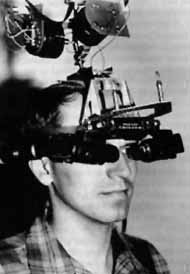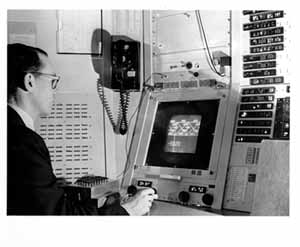MAT200A 03W
Julian Herring
Philosophy of Telepresence and Designing "The Ultimate Display"
Article 1: "Is there Love in the Telematic Embrace?" by Roy Ascott

Touch
Over the Internet
Touching
Molecules
Telepresence
in Medicine
Virtual
Reality Innovations and Patents
Transparent
Telepresence Research Group
Current Projects in Telepresence:
THE
ORNITORRINCO PROJECT - breif history of telepresence and info about this
project
The Ubiquitous
Telepresence Project
Sniffle
- Lab Equipment
First, a definition of telematics: “computer-mediated communications networking involving telephone, cable, satellite links…remote sensing devices, and capacious data-storage banks.”
Roy Ascott talks about how art is seemingly intertwined with scientific progress and the human quest for meaning. One concept that comes out of the philosophical discussion is that quantum mechanics has had an important impact on the way that art has evolved. For example, we see from the Heisenberg uncertainty principle that in a physical system we must alter the state of that system if we observe or measure the characteristics of the system. We can see that art has evolved to incorporate this concept in that we have art installations in which the observer’s actions are used to control the content transmitted by the piece of art. In older forms of art, we have more static content like paintings or sculpture. The meaning in this case must be transmitted through this static form. The meaning in the dynamic art of today, however, must be understood by the observer in a slightly different way, since the content of the art is constantly morphing. The meaning behind the piece is almost by default more in the technical aspects of the piece and the content production method, which becomes a metaphor that we use to understand the meaning behind the piece. From this, I believe the meaning of a piece may be more easily confused than with older forms of art even if it is just by the fact that the format by which the meaning is transmitted has changed. Another concept coming from physics and applied to art is the fact that a system always has an amount of uncertainty and noise.
The author talks about a Western artist Marcel Duchamp, who was “prophetic of the telematic mode.” In his works, Marcel used horizontal lines to show the concept of seeing all around, while older artistic pictorials used vertical lines, which indicate a 'tunnel-vision.' He also used the metaphor of the glass in which the observer can see through the glass and can see their reflection, again referring to the idea that the observer always affects the system they are observing.
In new arts, the author believes we will see more distributed artistic authorship and use of the vast world of communication technologies and distributed sensors and intelligence. However, he believes the computer is too solid in our artistic repertoire, but is the heart of the telematic system. He gives the sense that it is more important to use the intelligence of the computer than to just use it as a display platform. Telematic culture is about how telematics can change the way in which we operate together as a society. We will find that even though the ideas that we have can become omnipresent very quickly over the network that there is still individuality in the creative process.
In the article, Ascott touches on the question of whether the global network or vast parallel distributed processing networks will obtain a consciousness. We may get to a point where there is such a large number of transfers of data that it becomes equivalent to the number of neural firings in an instant in the human brain. Does this mean the network is conscious? The author believes the use of virtual reality environments will cause people to think about values, and personal identity.
There are so many possibilities for sensory input and output for this network. Video, audio, text, pressure sensors all will contribute to the sensing power of this network. Synthesis of voice, music, video will be output onto screens and speakers and other digitally controlled media. Now, we will discuss some of these devices in the article by Ivan Sutherland, called “The Ultimate Display.”
Article 2: "The Ultimate Display" by Ivan Sutherland

"Ultimate Display" Products that you can buy:
AromaJet
Fragrance Synthesis
HMD/VR-helmet
Displays
VR
Interface Devices
SensAble

"Ultimate Display" Products that you can buy:
AromaJet Fragrance SynthesisHMD/VR-helmet Displays
VR Interface Devices

In his article, Ivan Sutherland, a pioneer in virtual reality graphics, talks about thestatus of the display technology in 1965, when the paper was written. The capabilities included being able to print dots and lines, but not curves or area-filling pictures. Position input devices, like RAND tablet or light pen could be used by a user to point at locations in a virtual view. Knobs and joysticks could be used to change the viewing angle. He talks about the possibility of making smell and taste displays, force-feedback of joysticks, and design of joysticks with as many degrees-of-freedom as human arms. In theory, the use of eye-tracking could control various aspects of the view. The power of virtual reality graphics is in its ability to display things that wouldn’t exist in the real world.
In 1968, Sutherland and David Evans, a friend from the computer science
department at the University of Utah, established a new company called Evans &
Sutherland. The company was housed at the University
of Utah and employed students there. Evans thought of computers as
a simulation device, while Sutherland brought to the table his visualization
technology. Together, their company has developed and sold much of the
world's commercial
flight simulators. They also have made many products for military
use and digital
theatre for use in planetariums and science centers. Currently E&S
is under the direction of new leadership, since Evans retired and Sutherland
started working at Sun Microsystems.
of Utah, established a new company called Evans &
Sutherland. The company was housed at the University
of Utah and employed students there. Evans thought of computers as
a simulation device, while Sutherland brought to the table his visualization
technology. Together, their company has developed and sold much of the
world's commercial
flight simulators. They also have made many products for military
use and digital
theatre for use in planetariums and science centers. Currently E&S
is under the direction of new leadership, since Evans retired and Sutherland
started working at Sun Microsystems.
Cross-Synthesis

Agere Systems
The
Holodeck as a hightech crack pipe
Info
about Holodecks

The Holodeck as a hightech crack pipe
Info about Holodecks

As a fiber optic design engineer, at Agere Systems, formerly part of Lucent Technologies, I was designing the infrastructure of the internet, which helps to enable telepresence. It is rather amazing however to think about all the different ways the fiber optic equipment I designed would be used. I could imagine in just a single instant all the kinds of traffic that would flow through the optical fiber as just pulses of light. Light produced by lasers modulated at just the right frequency. My job would include designing transceivers using lasers, photodiodes, driver ICs, and other ICs. Then I would analyze the performace of the transceivers based on eye diagrams and bit-error-rate measurements.
Experience of working in industry for 2+ years and then coming back to school is a freeing experience. It’s freeing to be able to deal with anything from deep technical details of designing something like the “ultimate display” while also being able to ponder the psychological effects of such a device on it’s users. In industry, there is seemingly no time or need for creativity or philosophical thought. As an engineer, in many cases, we are expected to use established design principles and find low-cost parts to create a commodity type product that you may never see in use. Obviously this can be disconcerting to a creatively motivated engineer/artist.
As an amateur musician and 3D artist I have been exposed to art in the real domain of acoustics and physical space. As we have seen over the course of the past couple decades, computers have been used more and more to develop and distribute these sorts of multimedia in a digital format. I find it interesting to think of the ways in which I have created pieces: from recording music acoustically and then dumping that to a computer and manipulating the signal on the computer to doing everything by digital means. I have also investigated the thing that Ascott calls 'distributed artistic authorship,' which is starting to pop up more and more on the web. For example, Tonos.com allows musicians from all over the world to collaborate on musical pieces in a non-realtime way. You can listen to and add tracks to musical pieces that others have started, or you can start your own composition. The idea is just getting started and I believe there is a lot of room for innovation in this field. For example, in the future, when more bandwidth is available, we should see collaboration on visual works with video.
In my experience as a “Star Trek: The Next Generation” fan, it’s interesting to see the potential future of Ivan’s vision of virtual input devices and displays in the thing known as the holodeck. The holodeck as some may know is a virtual environment that is almost indecipherable from reality. One of the only differences being that the artificial intelligence of characters may not be as sophisticated as one would hope, but this is solely a product of the sophistication of the software running the simulation. Because human perception is limited, it seems fair to say that eventually, we could make an environment completely indecipherable from reality: light, sound smell, touch, and taste all accounted for with full accuracy and clarity.